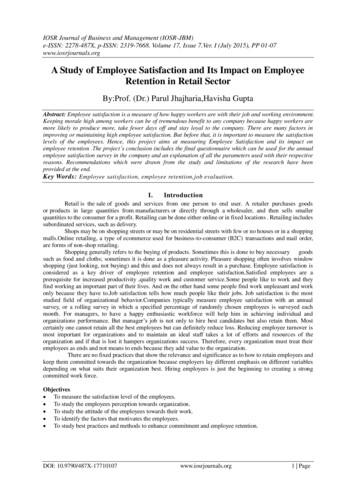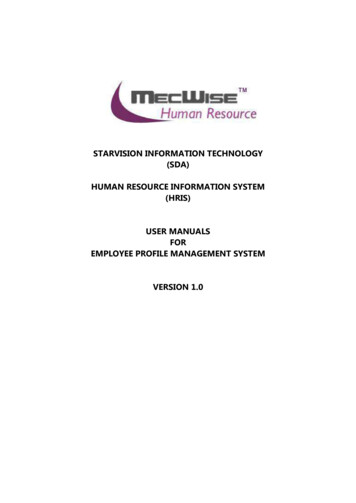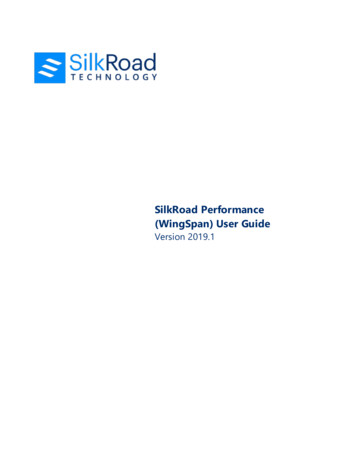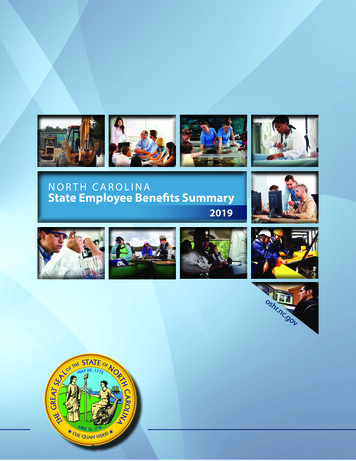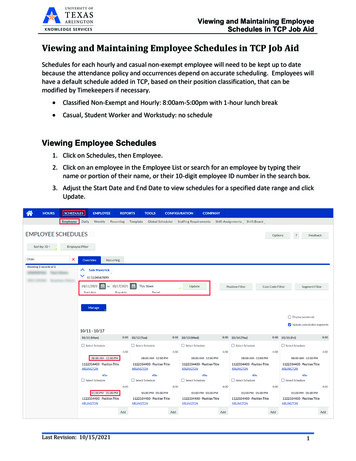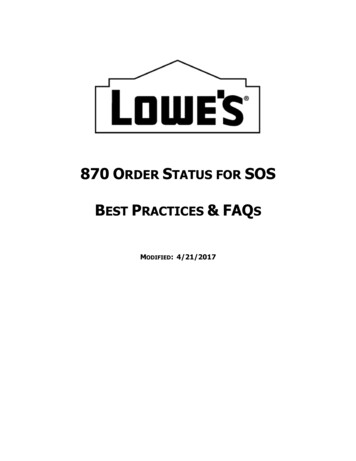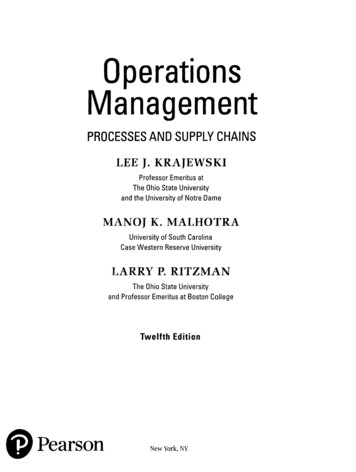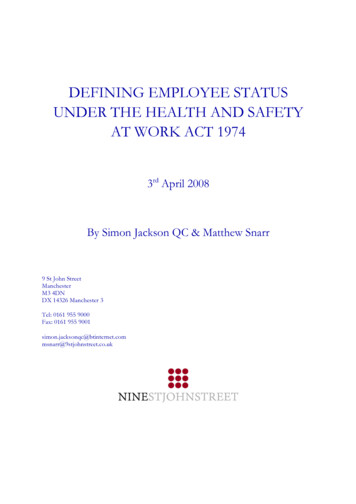
Transcription
DEFINING EMPLOYEE STATUSUNDER THE HEALTH AND SAFETYAT WORK ACT 19743rd April 2008By Simon Jackson QC & Matthew Snarr9 St John StreetManchesterM3 4DNDX 14326 Manchester 3Tel: 0161 955 9000Fax: 0161 955 reet.co.uk
Defining the Status of Employees under theHealth and Safety at Work Act 1974Introduction1.The definition of employee status in the context of both criminal and civil jurisdictions hasconsistently challenged lawyers, business, trade unions and the Courts alike. The test for allparties concerned has been to identify in clear, unequivocal language, a formula whichembodies the essential elements of what constitutes an employee. This exercise has notproved straightforward.2.The Courts have been besieged by competing interests for both a wider and narrowerdefinition of an employee. The undesirability of employee status from a tax perspective bringswith it additional burdens to business of health and safety protection. Some would-beemployees have been content to abandon this regulatory protection in favor of ensuringcontractual paid work albeit on a self employed basis.3.The advent of increased immigration has realised a new dynamic to the definition of employeestatus. The problem of poorly regulated migrant labour, both legal and illegal, was tragicallyhighlighted by the Morecambe Bay disaster. The regulatory response to this unfortunate eventwas realised in the Gangmaster Licensee Act 2004. The individuals now protected under thislegislation are defined as ‘workers’, which will be shown to be a wider definition than that ofemployees.4.The context of this seminar arises in advance of the forthcoming consideration of thedefinition of employee status in under the Health and Safety at Work Act 1974 by the Courtof Appeal in the case of R v Shah Nawaz Pola.1
5.The reason why the definition of employee is important under the 1974 Act is because itidentifies who the relevant / responsible ‘employer’ is, as there is no separate test for employerwithin the 1974 Act. The definition of ‘employee’ therefore points us towards the individual(or other legal entity) upon whom all the primary health and safety duties are then imposed,(as the employer) starting with the 1974 Act and coming up to date with the more recentregulatory regime of statutory instruments [i.e. The Management of Health and Safety at WorkRegulations 1999.]The Health and Safety at Work Act 19746.The 1974 Act was a very important step in advancing health and safety regulation within thecontext of domestic legislation. The Act followed the publication of the Report of the RobensCommittee (1972 Cmnd 5034). It was intended to consolidate the existing, but fragmentedhealth and safety provision which was then in force. Some commentators argue that we arenow in need of ‘Robens 2’ in order to both modernise and homogenize the existing regulatoryframework.7.The 1974 Act is, of course, the rock upon which so much of health and safety legislation isbuilt. When it was enacted, the Act had contained within it, its own special provision, for thecreation of any number of legislative offspring, namely Section 15 ‘Health and SafetyRegulations’.8.It is this Section which has given birth to so many of our current regulations. However it isthe mixed genus of these regulations which has, in reality, created a certain tension, which hasyet to be resolved, between our domestic health and safety legislation and EU sponsoredlegislation/directives.2
9.On the one hand the Health and Safety at Work Act 1974 can be viewed as a continuallyevolving legislative framework or structure, which has adapted with time, to provide everwider regulation in order to meet with the challenges our developing social, economic andindustrial landscape.10.On the other hand the Act may be seen as a rather stern legislative parent who keeps his/her‘daughters’, the offspring from a second (European marriage), either firmly locked up, or ifpermitted to go out, only when modestly dressed in the restrictive clothing of the ’74 Act,rather than the more cosmopolitan (European) fashions of the 1990’s.11.When we come to the key definitions, and therefore to defining duties, the question is goingto be; will the courts, where there is opportunity to ‘judicially legislate or interpret’ embracethe intention and language behind the EU ‘Framework Directive’ [89/391] or will they staywith the more restrictive definitions of domestic legislation?The Obligations on Employers12.S.2(1) of the 1974 Act enacts general duties on employers with regards to their employees:“It shall be the duty of every employer to ensure, so far as is reasonably practicable, the health, safety andwelfare at work of all his employees.”13.S.3(1) of the 1974 Act requires employers to look after the well being of persons who are notemployed by them:“It shall be the duty of every employer to conduct his undertaking in such a way as to ensure, in so far as isreasonably practicable, that persons not in his employment who may be affected thereby are not thereby exposedto risks to their health or safety.”14.These duties only apply to an employer. The 1974 Act does not define what constitutes anemployer. It is important to observe that it appears on its face that in order for s.3 to apply itis a pre-requisite that the Defendant ‘employer’ can actually be shown to employ someone inan approach that it consistent with the other statutory definitions contained in the Act.3
Definition of Employee with the 1974 Act15.S.53(1) states ‘employee’, “means an individual who works under a contract of employment [or is treatedby section 51A as being an employee], and related expressions shall be construed accordingly;” As statedabove, there is no definition of who or what constitutes an employer. The inference to bedrawn from the reference to ‘related expressions’ guidance, which is to be found within thesection, is that an ‘employer’ is therefore someone who employs ‘employees’ under a contractof employment.16.Therefore in order to understand who is an employee, we must have regard to the definitionof a ‘contract of employment’. S.53(1) defines a contract of employment as, “a contract ofemployment or apprenticeship (whether express or implied and, if express, whether oral or in writing);”17.It may be that the legislature took the view that a contract of employment was a creaturesufficiently well known to the law and it was therefore content to leave it to the courts toapply the principles established in the existing case law for determining when a contract ofemployment exists or does not exist. We believe that even if it was the case in 1974, it cannotbe the case today. There is an obvious doubt as to whether it was ever a readily identifiableconcept:'It is almost impossible to give a precise definition . It is often easy to recognise a contract of [employment]when you see it, but difficult to say wherein the difference lies' (Stevenson Jordan and Harrison Ltd vMacDonald and Evans [1952] 1 TLR 101 at 111, per Denning LJ).[The essential question is:] 'Was his contract a contract of [employment] within the meaning which an ordinaryperson would give to the words?' (Cassidy v Ministry of Health [1951] 2 KB 343 at 352, per Somervell LJ).18.An interesting feature of this discussion, is that if one looks at the ‘Preliminary’ to the Act ats(1)(a) we see that the intention of the Act, is, inter alia, to ‘secure the health, safety andwelfare of persons at work’. The reference to ‘persons’ is broader and wider than the morerestrictive definition of employees. It is akin the European language of ‘workers’. However,4
sections 2 and 3 of the Act, the most important provisions, define the legal tests in terms ofemployers and employees.The European Dimension19.Reference to statutory instruments and the EC Directives they seek to implement may assistthe Courts in their interpretation of the extent of an employer’s duties. The Management ofHealth and Safety at Work Regulations 1999 provides an excellent starting point. The ’99Regulations replaced and revoked the MHSW Regulations 1992, which had been intended tointroduce many of the provisions of the Framework Directive [89/391].20.The ’99 Regulations also introduced part of the Temporary Workers Directive [June 1991],(which had in turn had introduced, in part, the EU Framework Directive’s concept of‘temporary workers’ to domestic legislation).21.The Framework Directive’s definition of employer within, Article 3, is much wider than thatof the 1974 Act:For the purposes of this Directive, the following terms shall have the following meanings:(a) worker: any person employed by an employer, including trainees and apprentices but excluding domesticservants;(b) employer: any natural or legal person who has an employment relationship with the worker and hasresponsibility for the undertaking and/or establishment;5
(c) workers' representative with specific responsibility for the safety and health of workers: any person elected,chosen or designated in accordance with national laws and/or practices to represent workers where problemsarise relating to the safety and health protection of workers at work;22.When we look at Articles 3 and 5 of the Framework Directive we see reference to the conceptof a broader ‘employers’ duty to ‘workers’. The term employer is bound up in a definitionwhich refers to ‘an employment relationship’. This is a much broader and adaptable definitionof the employer.23.Articles 6 and 10 of the Framework Directive stipulate that there ought to be obligations onemployers to assess risks to which workers are exposed and provide workers withinformation. Yet regulations 3 and 12 of the ’99 Regulations still define those duties byreference to the definition of employer and employees under the 1974 Act.24.In other words the wider duties hinted at within the context of social justice, the EmploymentRights Act 1996 (“the ERA”), does not appear to have been adopted in the context of healthand safety legislation. Indeed the ERA’s definition seems limited to that Act only, see below.The Concept of Workers25.The term worker is deliberately wider than employee. It is capable of covering persons notengaged under a contract of employment, such a self-employed individuals and those whosestatus is ambiguous. It is designed to be more inclusive. The term originated in trade unionstatutes, it was adopted by the Wages Act 1984, so when this was consolidated into the ERAthe latter Act had to have a definition of the term worker.26.The wide applicability of the concept of worker has been recently seen in litigation concerningthe Working Time Regulations 1998. Many workers albeit not employees have been keen toassert their rights to holiday pay. In Byrne Bros (Farmwork) Ltd v Baird [2002] IRLR 96 the EATupheld an employment tribunal’s finding that building workers working under a6
subcontractors agreement which provided that no work was obligatory on either side, wereworkers even though they could have worked elsewhere. This case was later approved by theCourt of Appeal in Wright v Redrow Homes Ltd [2004] EWCA Civ 469.The Gangmasters (Licensing) Act 200427.The Gangmasters (Licensing) Act 2004 set up a regulatory regime whereby gangmastersproviding labour now have to do so under a license provided by the Gangmasters LicensingAuthority. It is an offence to provide labour to the agriculture or fishery industry without sucha license, see s.3 and s.6.28.S.4 of the 2004 Act widely defines gangmasters as follows:This section defines what is meant in this Act by a person acting as a gangmaster.(2) A person (“A”) acts as a gangmaster if he supplies a worker to do work to which this Act applies foranother person (“B”).(3) For the purposes of subsection (2) it does not matter—(a) whether the worker works under a contract with A or is supplied to him by another person,(b) whether the worker is supplied directly under arrangements between A and B or indirectly underarrangements involving one or more intermediaries,(c) whether A supplies the worker himself or procures that the worker is supplied,(d) whether the work is done under the control of A, B or an intermediary,(e) whether the work done for B is for the purposes of a business carried on by him or in connection with servicesprovided by him to another person.(4) A person (“A”) acts as a gangmaster if he uses a worker to do work to which this Act applies inconnection with services provided by him to another person.(5) A person (“A”) acts as a gangmaster if he uses a worker to do any of the following work to which this Actapplies for the purposes of a business carried on by him—(a) harvesting or otherwise gathering agricultural produce following—7
(i) a sale, assignment or lease of produce to A, or(ii) the making of any other agreement with A,where the sale, assignment, lease or other agreement was entered into for the purpose of enabling the harvestingor gathering to take place;(b) gathering shellfish;(c) processing or packaging agricultural produce harvested or gathered as mentioned in paragraph (a).In this subsection “agricultural produce” means any produce derived from agriculture.(6) For the purposes of subsection (4) or (5) A shall be treated as using a worker to do work to which this Actapplies if he makes arrangements under which the worker does the work—(a) whether the worker works for A (or for another) or on his own account, and(b) whether or not he works under a contract (with A or another).(7) Regulations under section 3(5)(b) may provide for the application of subsections (5) and (6) above inrelation to work that is work to which this Act applies by virtue of the regulations.29.The definition of gangmaster is deliberately wide. Different considerations may apply to therigid standards of the 1974 Act as opposed to the less onerous requirement to be a licensedgangmaster under the 2004. Nevertheless, the problem of unregulated migrant labourpervades the construction industry and the workers in that industry who do not attainemployee status seem to be afforded less protection than workers within the agriculture orfisheries industries.The Employment Rights Act 199630.S.230 of the Employment Rights Act 1996 provides:8
(1) In this Act “employee” means an individual who has entered into or works under (or, where theemployment has ceased, worked under) a contract of employment.(2) In this Act “contract of employment” means a contract of service or apprenticeship, whether express orimplied, and (if it is express) whether oral or in writing.(3) In this Act “worker” (except in the phrases “shop worker” and “betting worker”) means an individualwho has entered into or works under (or, where the employment has ceased, worked under)—(a) a contract of employment, or(b) any other contract, whether express or implied and (if it is express) whether oral or in writing, whereby theindividual undertakes to do or perform personally any work or services for another party to the contract whosestatus is not by virtue of the contract that of a client or customer of any profession or business undertakingcarried on by the individual;and any reference to a worker’s contract shall be construed accordingly.(4) In this Act “employer”, in relation to an employee or a worker, means the person by whom the employee orworker is (or, where the employment has ceased, was) employed.(5) In this Act “employment”—(a) in relation to an employee, means (except for the purposes of section 171) employment under a contract ofemployment, and(b) in relation to a worker, means employment under his contract;and “employed” shall be construed accordingly.31.When drafting the ERA the legislature importantly took the view that it was not sufficient toprovide only definitions of an employee and contract of employment. The definition ofemployer embodies the notion that an employee is capable of being defined by reference to9
not just employees but also the wider concept of ‘workers’. An employer can be someone whoemploys workers. On its face this expands the definition of what constitutes an employerfurther than the 1974 Act.32.Arguably, within the context of health and safety law, there is currently no clear definition ofthe terms ‘employer’ and ‘employee’. Furthermore, the current definition and its applicationare out of kilter with the European approach to health and safety law and the domesticinterpretation of the employment relationship in the field of employment law.33.All this may be about to change in the context of an appeal in the case Regina v Shah NawazPola, which is due before the Court of Appeal shortly.R v Shah Nawaz Pola34.This case involved a prosecution of a man whom the Crown alleged had employed a numberof migrant (Slovakian) workers in order to undertake building works on a large extension tohis family home in Bradford.35.The defendant was prosecuted in respect of a number of offences, including an offence underSection 2(1) of the Health and Safety at Work Act 1974. It was the Crown's case that theseworkers were the defendant’s ‘employees’ and that as such he, as their employer, owed themthe usual statutory duties.36.The defendant denied he was their employer. He claimed they were employed by hiscontractor and/or that they were not his employees because there was no evidence of therequired ‘mutuality of obligations’, as between himself and the workers, such as could properlyfound a finding that there was a contract of employment between them.10
37.The defendant was convicted after a trial, but he has now been given leave, upon a renewedapplication, to appeal his Section 2(1) conviction, and therefore to argue that the migrantworkers were not the defendant’s ‘employees’. The appeal is to be held shortly.38.The approach of the trial judge, when directing the jury, in the absence of a definition withinthe context of the Act itself, was to look to the definition of ‘employee’ in the context ofemployment law. We shall now examine the approach adopted by the tribunals and courtswithin this field.Approaches in Employment Law39.The editors of ‘Harvey on Industrial Relations’ observe that a satisfactory definition of anemployee has proved elusive.“A satisfactory definition of 'employee' has proved elusive. An employee is one who serves, in the sense that he putshimself and his labour at the disposal of another (his 'employer'), in return for some remuneration in cash or kind. Theresulting contract is called a contract of employment. But it is difficult to define absolutely the degree of submissionnecessary to constitute 'employment'; and in any event not everyone who serves is necessarily an employee in the narrowestsense.”Policy40.A particular problem with finding and applying a universal definition of the term ‘employee’ isthat the courts have had to adopt an individual approach depending on the legislation whichthey are required to interpret. Many of these cases focus on the nature of the ongoingrelationship, (if any,) between the claimant ‘employee’ and his or her ‘employer’.41.The focus is more often on the rights and entitlements of the worker/employee, rather thanon the nature and/or the extent of the employer’s statutory and/or common duties in respectof that individual.The Tests for Employee Status11
42.Interestingly it is the field of employment law which has generated the most appeal authoritieson the issue of employee status as opposed to health and safety or personal injury. This isunderstandable given the right of unfair dismissal turns on whether a complainant can fithimself into the definition of employee under s.230, which mirrors the 1974 Act definition.43.In order to cover the wide range of different scenarios the Courts have formulated a variety ofdifferent legal tests to apply when considering the employee status of an individual.44.The starting point for most employment lawyers seeking to ascertain the existence of acontract of service is the case of Ready Mixed Concrete (South East) Limited v Minister of Pensionsand National Insurance [1968] 2 QB 497. MacKenna J’s judgment identified the criteria fordetermining whether a contract of employment exists the following way:“A contract of service exists if three conditions are fulfilled.(i) The servant agrees that in consideration of a wage or otherremuneration he will provide his own work and skill in the performance ofsome service for his master.(ii) He agrees expressly or impliedly that in the performance of that servicehe will be subject to the other’s control in a sufficient degree to make thatother master.(iii) The provisions of the contract are consistent with its being a contractof service. As to (i). There must be a wage or other remuneration. Otherwise therewill be no consideration, and without consideration no contract of anykind. The servant must be obliged to provide his own work and skill.Freedom to do a job either by one’s own hands or by another’s isinconsistent with a contract of service, though a limited or occasionalpower of delegation may not be.”45.After the important concepts of personal service and control comes the most importantdeterminative factor in construing whether a contract constitutes a contract of service or not,this is the concept of ‘mutuality of obligation’. In Carmichael v National Power PLC [2000] IRLR43 the House of Lords held that there was “an absence of irreducible minimum of mutual12
obligation necessary to create a contract of service” such a condition was a prerequisite for afinding that a contract of service existed. A mutuality of obligation is best understood as anobligation to provide work and obligation to undertake the work when provided.46.In James v Greenwich MBC [200] UKEAT/0006/06/ZT Mr Justice Elias confirms thepossibility that such an irreducible minimum of mutual obligations may continue to existthrough an umbrella contract of employment where there are a number of contracts of servicewhich are interrupted in time, see para 19.47.Determining the existence of a contract of employment had proved particularly troublesomein agency cases where an employment agency contracts workers to work for the end serviceuser. These tripartite relationships often require the Courts to examine the existence of anymutuality of obligation.Discussion48.However in the context of Regulatory and criminal law, it is we suggest important to lookbeyond the technical formalities of contract law and look at the realities of the relationshipand the intention of Health and Safety at Work Act 1974 and the protection it was intendedshould be provided to ‘employees’.49.In this regard we invite reference to the decision of Elias J in the EAT case of Mrs. James vRedcats Brands Limited [Transcript UKEAT/0475/06/DM] Whilst this case focused on whetherthe appellant was a ‘worker’ as defined by relevant minimum wage legislation, the learnedjudge undertook a very careful review of the authorities in relation to the issue of ‘mutuality ofobligations’, including the House of Lords decision in the case Carmichael v National Powerrelied upon by the appellant. [See paragraphs 75 to 94 below]50.At paragraph 84 Elias J. observed:13
‘Mutuality of obligation’.78 The only obligations which in practice are likely to arise are some duty on the employer to offer work and some dutyon the worker to accept work if offered. If there are no mutual obligations of any kind, there can be no contract. That is asimple principle of contract law, not unique to contracts of employment.83. Since when working she is plainly providing a service, the two potentially relevant questions are whether she is obligedto perform the service personally; and whether she is doing so in the course of a business. The fact that there is no contractin place when she is not working - or that if there is, it is not one which constitutes her a worker - tells us nothingabout her status when she is working. At that point there is a contract in place. If the lack of any mutualobligations between engagements precluded a finding that an individual was a worker whencarrying out work pursuant to an engagement, it would severely undermine the protectionwhich the minimum wage legislation is designed to confer.84. Many casual or seasonal workers, such as waiters or fruit pickers or casual buildinglabourers, will periodically work for the same employer but often neither party has anyobligations to the other in the gaps or intervals between engagements. There is no reason inlogic or justice why the lack of worker status in the gaps should have any bearing on the statuswhen working. There may be no overarching or umbrella contract, and therefore noemployment status in the gaps, but that does not preclude such a status during the period ofwork. If casual and seasonal workers were to be denied worker status when actually workingbecause of their lack of any such status when not working, that would remove the protectionof minimum wage and other basic protections from the groups of workers most in need of it.85. Accordingly, I would respectfully dissent from the decision of the EAT in the Bly case. The facts were that a labourerwas employed as what was termed a "self employed sub contractor". The employers employed some 220 such people. Itwas accepted that he was not an employee. He was subject to a carefully drafted contract under which he was under noobligation at any time to do anything for the employer and nor they for him.86. The issue was whether he was a worker under the Working Time Regulations 1998 when he was at work. Amajority of the EAT considered itself bound by Mingeley to conclude that the contact did not confer upon him the statusof a worker even when work was being performed. The employer was not obliged to offer work nor the worker to accept itand that was considered fatal to his status as a limb (b) worker. I respectfully disagree. For reasons I have given, I do notaccept that Mingeley has anything to say about the status of the individual once work is actually being performed.87. Furthermore, in my judgment the decision in Bly is inconsistent with at least two decisions of the higher courts. Inthe Carmichael case the question was whether certain guides could be said to be employed14
under contracts of employment when they were not actually at work. The House of Lords held thatthey could not since there was no mutuality of obligation in such periods. However, Lord Hoffmann observedin his speech (p.1235) that "it may well be that, when performing that work, they were beingemployed." If Bly were correct, they could not be so employed.88. Perhaps even more directly on point is the decision of the Court of Appeal in McMeechan v Secretary of State forEmployment [1997] ICR 549. The question there was whether the worker was an employee of an employment agency.There was no obligation on the employee to accept any particular offer of employment that might be made or any obligationto offer work to him. The worker did, however, carry out engagements given by the agency. The agency went into insolvencyand the question was whether he was an employee so as to recover against the Secretary of State pursuant to the insolvencyprovisions in the Employment Rights Act.89. Waite LJ, with whose judgment Potter and McCowan LJJ agreed, held that there was no inconsistency in findingthat there was a contract of employment for particular contractual stints even though there wasno continuing overarching contract between the agency and the individual because of a lack ofmutual obligations in the period between engagements. Waite LJ put the matter as follows (page 563):"In a case like the present where the money claimed is related to a single stint served to one individual client, it is logical torelate the claim to employment status to the particular job of work in respect of which payment is being sought. I note thatthe editors of Harvey on Industrial Relations and Employment Law appear to take a similar view, where they suggest, atparagraph A53: ‘The better view is not whether the casual worker is obliged to turn up for, or do,the work but rather if he turns up for, and does the work, whether he does so under a contractof service or for services.'"90. I think a useful analogy can be drawn with the decision of the Supreme Court of the UnitedStates in US v Silk (1946) 331 US 704. This case was considered by MacKenna J in the seminalcase of Ready Mix Concrete (South East) Ltd v Minister of Pensions & National Insurance[1968] 2 QB 497 at 521. Silk sold coal by retail. They used un-loaders to move coal from railwayvans into bins. The un-loaders were under no obligation to do any work at all. They came tothe yard when they wished. They were given a wagon to unload and somewhere to put thecoal. They provided their own tools and they were paid by reference to the amount of coalshifted.91. The issue was whether they had the protection afforded by the Social Security Act 1935.That depended on whether they were employees. All nine judges held that they were, therebydisagreeing with the two lower courts. The Court said this:15
"That the unloaders did not work regularly is not significant. They did work in the course ofthe employer's trade or business. This brings them under the coverage of the Act. They are ofthe group that the Social Security Act was intended to aid."92. The fact that the unloaders had no relationship with Silk when they were not working, andthat they were entirely free to work or not, did not affect their status when working. Any otherconclusion would have frustrated the operation of the Act. In my judgment that conclusion isequally apt here.93. Accordingly, in my view the fact that there is a lack of any mutual obligations when nowork is being performed is of little, if any, significance when determining the status of theindividual when work is performed. At most it is merely one of the characterist
Health and Safety at Work Regulations 1999 provides an excellent starting point. The ’99 Regulations replaced and revoked the MHSW Regulations 1992, which had been intended to introduce many of the provisions of the Framework Directive [89/391]. 20. The ’99 Regulations also introd




